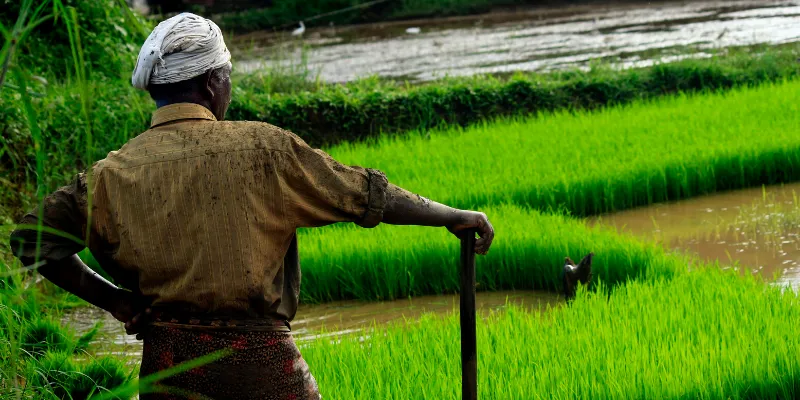Groundwater: Making The Invisible Visible
Water being an essential resource, it is important to understand and formulate ways to manage water efficiently.
Our country has been facing an alarming water crisis, where as many as 21 cities may run out of groundwater, according to a report by NITI Aayog. This underscores the need to evolve a policy that not only addresses imminent challenges, but also establishes a framework and pathway to sustainable, efficient, and equitable management of surface and groundwater resources.
Limit the area under water-guzzling crops and promote less water-intensive crops:
Around 90 percent of India’s water is used for agriculture. Without reducing water for agriculture, we can never hope to meet the country’s drinking and domestic water needs. Just three water-intensive crops – rice, wheat, and sugarcane – consume almost 80 percent of irrigation water.

A reduction in the area under these crops, together with crop diversification and use of micro-irrigation, can contribute to alleviating water scarcity and making available additional water resources for other needs, especially in rainfed and drought-prone regions of the country. To reduce water-guzzling crops and increase the area under ‘water-lite’ crops such as millets, pulses, and oilseeds, the minimum support prices (MSPs) of these should be further increased as incentives for farmers. The increased cultivation of these will eventually improve groundwater level.
After drinking water, prioritise water for ecosystem needs:
The National Water Policy (NWP) 2012 prioritises water for drinking and domestic needs, irrigation and minimum ecological needs on an equal and ‘high priority’. After water for drinking and domestic needs, ‘water for ecology and the environment’ must be the second most important priority.
The environment and its ecology is what provide the essential and crucial ‘ecosystem services’- such as water, food, fuel, wood, and fibre as well as balancing the climate – on which the survival, sustenance, and progress of the human race depend.
Need for an ‘Ecosystem-based Adaptation’ Approach:
While watershed development is still one of the key programmes for water resource development, particularly in rainfed regions, in the context of increasingly adverse impacts of climate change, there is an urgent need to change its approach to one that not only focuses on water harvesting but also on building resilience as well as the adaptive capacities of local communities and the local eco-system. For this, a sub-basinal and ecosystem-based, collaborative, science-based, multi-sectoral, integrated and climate-responsive approach involving multiple stakeholders across levels should be promoted.
Groundwater to be priced:
The interconnectedness of surface and groundwater hydrology has to be recognised, as both these are forms of the same resource. Hence, it is not logical to price only surface or canal water while making groundwater a free gift for a few economically better-off farmers.
Wider observations show that the absence of groundwater pricing is one of the causes of indiscriminate extraction and depletion of these resources in many regions. A system of groundwater pricing based on the area under irrigation, similar to canal water, should be introduced to protect this resource for future generations.

Groundwater contamination should be treated as a punishable offense:
To control groundwater contamination by urban sewage and industrial effluents, the ‘polluter pays’ principle is not a sufficient deterrent; rather, it allows industries to pollute and pay. Hence, groundwater contamination should be treated as a punishable offense and enforced.
Need for inclusive local water management institutions:
Community user group organisations such as Water Users Associations (WAUs), Village Watershed Committees, etc., in which women play a dominant role should be promoted. The managerial capacities of such bodies should be progressively built up and financial resources, as required should be devolved to them.
Water and Aquifer Literacy:
A promotion of water literacy based on the local hydrogeology and aquifers will help people realise that water is indeed a public and hence, a shared good. Capacity building of communities and participatory generation of local knowledge on these issues play an important role in raising awareness, facilitating increased community ownership and establishing inclusive and effective water governance institutions and practices locally.
Making the invisible aquifer characteristics and its relationship with surface hydrology visible has great potential for sensitising people on local water dynamics.
Cautious promotion of solar energy:
As fallow and barren lands are proposed to be installed with solar panels in Budget 2020, it may result in reducing the village commons which play an important role in maintaining the local ecosystem balance and village livelihoods. Alternatively, the canals and water reservoirs may be a more appropriate choice to install solar panels as a reduction in water evaporation will be a secondary benefit.
In conclusion, we propose a clear roadmap together with a clear responsibility and accountability structure at all levels should be spelled out to save groundwater. Adequate resources in terms of trained human resource, finances and technologies, adoption of an ecosystem-based approach and climate proofing of watersheds, the Water Governance Standard, climate-resilient agriculture and policies should be adopted to shift the ‘use narrative’ in the water sector in India.
(Disclaimer: The views and opinions expressed in this article are those of the author and do not necessarily reflect the views of YourStory.)



![[Monday Motivation] Meet the man who left a lucrative job to rejuvenate lakes in Bengaluru](https://images.yourstory.com/cs/5/79900dd0d91311e8a16045a90309d734/MMAnandfeat-1642938046937.jpg?fm=png&auto=format&h=100&w=100&crop=entropy&fit=crop)




